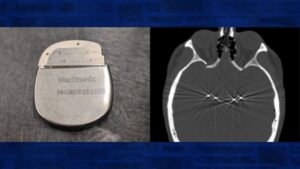 (image credit: Duke)
(image credit: Duke)
A team of physicians, neuroscientists and engineers at Duke University has demonstrated two new strategies that use deep brain stimulation to improve the symptoms of Parkinson’s disease.
By simultaneously targeting two key brain structures and using a novel self-adjusting device, the team showed that they can efficiently target and improve disruptive symptoms caused by the movement disorder.
The research appears online in the journal Brain.
“Physicians place the electrodes for DBS in either the subthalamic nucleus or the globus pallidus, which are two structures in the brain closely associated with movement,” said senior author Dennis Turner, professor of neurosurgery, neurobiology, orthopaedic surgery and biomedical engineering at Duke. Turner conceived and organized the research and assembled the interdisciplinary team.
Read the full article here.
